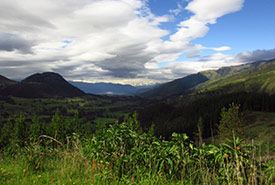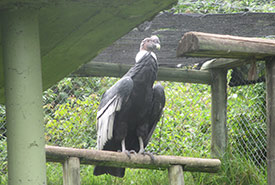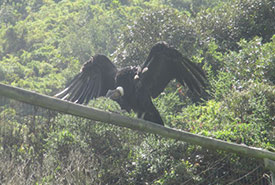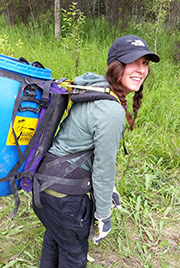Conservation from abroad: Saving the Andean condors

Zuleta, Ecuador - the town near the hacienda where I stayed for one month doing condor conservation. (Photo by Carissa Wasyliw)
At 3:19 a.m. on January 1, 2015, I left my home to embark on a four-month adventure through South America. Having just finished my degree, I was feeling a little stir crazy and ready for a change of pace. My New Year’s resolution was to live every day as an adventure, and that I did.
My most memorable experience from the whole trip was my time spent volunteering for a not-for-profit organization that is leading a captive breeding program for the Andean condor on a hacienda (farm) in northern Ecuador. These birds are globally listed as near threatened by the International Union for Conservation of Nature and as critically endangered in Ecuador.
In South America, especially the northern countries, the Andean condor risks extirpation (local extinction). In Ecuador, experts think that there are only 50 left in the wild. As populations are declining primarily due to illegal hunting, an expansion of agricultural land, and in turn a shortage of food for the birds, it is imperative that we reverse this trend.

Andean condor at the Galo Plaza Lasso Foundation. (Photo by Carissa Wasyliw)
The Andean condor is the largest flying land bird on the globe, and is one of the few species that is monogamous. Its offspring take at least seven years become fully-grown and mature. Once they are grown, condors will only lay one egg every two years in the wild, and once a year in captivity.
The condor’s long reproductive cycle and small brood size provides many challenges for those trying to re-establish the population. The Galo Plaza Lasso Foundation has seven captive condors that were injured or kept illegally and are no longer able to survive in the wild. Finding matches between these seven (and others in captivity in the country) that are genetically and emotionally compatible (have chemistry) further decreases the chances of successful breeding.
Yet hope is not lost! By taking advice from successful projects with Andean condors in Argentina and a similar species, the California condor, in United States, the biologists at the foundation are putting forward their best efforts for the recovery of these birds. In addition to the breeding and research efforts, they are working on educating locals and children about the true biology and behaviour of Andean condors, in attempts to change misconceived notions about them.

Conservation of Andean condors requires a multifaceted strategy. (Photo by Carissa Wasyliw)
Helping people of all ages engage with nature also encourages people to feel connected with it, and learn to love it and want to conserve it. Change doesn’t happen overnight, but it starts by sowing seeds of thought in people’s minds. If you nurture and let these seeds grow, they can blossom into great things.
Having had a few school groups come and visit us, it was very neat to see it happen within the children, by their questions, the brightness in their eyes, and their interest. They are the ones who have the power to make the most meaningful changes.
I did many things after leaving the hacienda, but I will always remember the determination and devotion of these biologists and staff members for these birds. I am confident that they will make a difference and help the status of the condor, but it will be a long road to success. I hope very much that one day it will be a common sight to see the Andean condor soaring high above the Andean mountains.
Visit Galo Plaza Lasso Foundation for more information about the project and their efforts.


